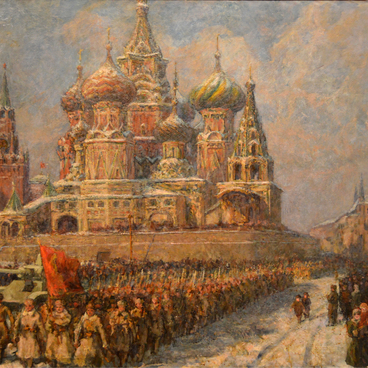Collection of the Kurgan Regional Art Museum includes many works of the 20th century artists and therefore features a certain portrait of the epoch. One of the gems of its collection is the painting Old Ural by the People’s Artist of the USSR Boris Fyodorovich Domashnikov. Russia and the beauty of its nature has always been the main subject of the painter’s art. Life forever linked Domashnikov with Ural and its territories, which were the main characters of his art. In 1935 the artist’s family moved to Ufa, where his father worked at the construction of a big factory. In 1945 Domashnikov entered and in 1950 he graduated from the Ufa Theatre and Art College. The artist’s creative search was very curious. In the 1960s and in the 1970s many Soviet painters were fascinated by the Severe Style or, while travelling around Russia they were discovering the beauty of its nature in the northern and the central Russian regions. Domashnikov followed his own path. Like other painters of the 1960s he was interested in the monuments of traditional Russian architecture. For instance, there’s a painting entitled There, Where the Frescos of Dionisius are dedicated to Ferapontovo, in the collection of the Kurgan museum. However, Domashnikov didn’t look far into the past, nor he felt nostalgic about the past times. On the contrary, the artist lively inserted old monuments into the modern reality turning them into participants of the human’s everyday life.
It is possible that for this reason the painter addressed to the industrial landscape, and the motif of the city suburb appeared in his art. Many of Boris Domashnikov’s paintings were dedicated to Ural, Bashkortostan, its nature and cities. The theme of fellow countrymen and their life became the core motif of the artist’s work.
Old Ural is one of the most important artist’s works dedicated to Ural. The massive canvas demonstrates the city life among the giant mountains striking the imagination with their majestic beauty. Domashnikov always interlaced nature with the artistic narrative. The work combines harmony of the surrounding world with certain epicism and monumentalism. For creating such an effect, the artist used a special panoramic effect while constructing the composition. The sky-line almost lacks or is heavily moved to the upper part of the canvas. The work consists of five spatial plans, which let Domashnikov fully open the richness and joyfulness of the Uralians’ life. Such composition makes the painting similar to the mosaic. In connection with its bright palette the flat image evokes the feeling of harmony between the human and their surroundings.
It is possible that for this reason the painter addressed to the industrial landscape, and the motif of the city suburb appeared in his art. Many of Boris Domashnikov’s paintings were dedicated to Ural, Bashkortostan, its nature and cities. The theme of fellow countrymen and their life became the core motif of the artist’s work.
Old Ural is one of the most important artist’s works dedicated to Ural. The massive canvas demonstrates the city life among the giant mountains striking the imagination with their majestic beauty. Domashnikov always interlaced nature with the artistic narrative. The work combines harmony of the surrounding world with certain epicism and monumentalism. For creating such an effect, the artist used a special panoramic effect while constructing the composition. The sky-line almost lacks or is heavily moved to the upper part of the canvas. The work consists of five spatial plans, which let Domashnikov fully open the richness and joyfulness of the Uralians’ life. Such composition makes the painting similar to the mosaic. In connection with its bright palette the flat image evokes the feeling of harmony between the human and their surroundings.


